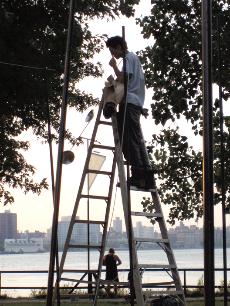After realizing the slow progress New Orleans has made after Hurricane Katrina, Loyola visual arts alum Takashi Horisaki responded with his artwork to the situation.
Horisaki, who lived and studied in the city, said he felt that people outside Louisiana didn’t understand the status of New Orleans, and it was time for him to make people aware of it.
Horisaki made a latex replica of the surface of a house in the Lower 9th Ward, creating a sculpture that represents the tragedy New Orleans has experienced.
“So much of what we encounter from the city is photographic, and you lose the sense of scale and reality that a physical object can provide,” he said in an e-mail to The Maroon.
“Social Dress New Orleans – 730 days” represents the two years (730 days) of efforts to rebuild New Orleans after Hurricane Katrina. Its goal is to make outsiders aware of New Orleans’ process of demolition, construction and recovery. According to Horisaki, the name of the piece comes from a series of architectural works he has been doing, The Social Dress series.
Horisaki, BFA ’03, said he surveyed several areas in New Orleans to find possible houses. He looked for owners to get their permission, but the Johnson family, who own the Caffin Avenue house he latexed, were the only ones he was able to reach.
“I was happy their house was the one that worked out because I like the site,” he said. According to Horisaki, the house was old and protected in front by two giant old trees. “In Japan, large trees are thought to be house gods, and I felt like this house was still standing because of the protective influence of the trees,” he said.
The Johnson family had given up on efforts to repair the house, Horisaki said. The family didn’t have enough money, and they had left the house but rented it out.
Horisaki didn’t have problems entering the property since “no one (had) control over that kind of thing.” He said it would be best for him to get permission from the Johnsons to be in the property, although he didn’t need it. It was easier for him to explain what he was doing to the house.
“I wanted to make certain I respected the owners, the neighborhood and the city,” he wrote.
A MOVING OBJECT
Takashi Horisaki may have gotten the perfect house to represent New Orleans’ flooding and slow recovery, but he had some problems with meeting his deadline. The Army Corps of Engineers came up with a list of houses to be demolished, and the Caffin Avenue house was one of them.
According to Horisaki, the Army Corps of Engineer kept the house at the end of the list of demolitions. “Every week or so they would call me to let me know how long it would take them to finish the batch of houses they had at that time,” Horisaki said.
Horisaki finished the latex mold on July 11.
On July 12 at 7 a.m., the Army Corps of Engineers demolished it.
Horisaki took the Caffin Avenue house mold to New York. His purpose was to make clear to New Yorkers how much was left to be done in New Orleans.
“The city is not well into reconstructing buildings, as many outsiders seem to think, but rather still dealing with the clean-up and demolition,” he said.
According to Horisaki, many people have told him after visiting the pieces how moved they felt when they confronted an object from New Orleans.
Horisaki hasn’t been able to cover the costs of the production. He said he hopes to tour the piece to other parts of the country. Meanwhile, the piece will stay in New York through Oct. 28.
LOYOLA STUDENTS HELP OUT
Takashi Horisaki didn’t work alone.
He had three Loyola interns – junior Tuyen Nguyen, sophomore James Goedert and sophomore Rebecca Parker, all visual arts majors who helped him during the process of latexing the house.
Nguyen found out about Horisaki’s project through her sculpture teacher, Mark Grote, who had also been Horisaki’s instructor.
Horisaki said he had the interns work on a variety of tasks. The interns helped in the building process. They put cheesecloth, a loosely woven cotton gauze, in between the layers of latex so it would strengthen the layers and become more fabric-like.
The work was demanding. The latex layers had to be stuck firmly to the cheesecloth or it would come off of the other layers.
“It was very time consuming,” Nguyen said, adding that the interns worked until late at night and even in the rain.
Goedert said he worked on the Caffin Avenue house about five days a week. Sometimes, he spent the entire week on it.
Students were under the pressure of Horisaki’s deadline. Nguyen said she used other methods to work faster since the Army Corps of Engineers had to demolish the house. However, Nguyen said it was better to avoid any mistake.
They found they also experienced Horisaki’s strictness. According to Goedert, Horisaki was meticulous and a perfectionist when working on his sculpture.
For Loyola interns, working with Horisaki meant taking the good with the bad.
“Doing the piece in general was a good experience but it (required a lot) of work,” he said. “You don’t get to see the final project for three months.”
Despite the pressure and stress, Nguyen said that she enjoyed the work.
“You can gain from everything, even if they’re bad experiences.”
Andrea Castillo can be reached at acastil1@loyno.edu.






